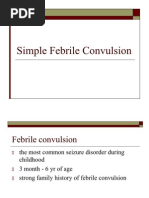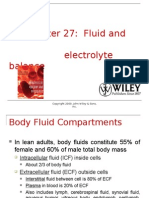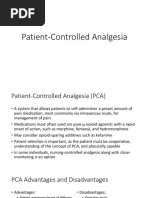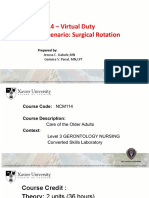Case Study
Case Study
Uploaded by
Joey ParkCopyright:
Available Formats
Case Study
Case Study
Uploaded by
Joey ParkCopyright
Available Formats
Share this document
Did you find this document useful?
Is this content inappropriate?
Copyright:
Available Formats
Case Study
Case Study
Uploaded by
Joey ParkCopyright:
Available Formats
Case Study: Erectile Dysfunction
Adult Case Study Erectile Dysfunction Joey Park M00351341 InterAmerican University of Puerto Rico- Metro Campus May 2011
Introduction Patient is a 75 year old male patient with a history of hypertension , diabetes, prostate cancer, presenting to urology clinics with erectile dysfunction refractile to oral medications. He will be scheduled for a prosthesis replacement. Patient has had history of several abdominal surgeries. For that reason, ambicor prosthesis will be placed.
Case Presentation Erectile dysfunction (ED, "male impotence") is a sexual dysfunction characterized by the inability to develop or maintain an erection of the penis during sexual performance. A penile erection is the hydraulic effect of blood entering and being retained in sponge-like bodies within the penis. The process is often initiated as a result of sexual arousal, when signals are transmitted from the brain to nerves in the penis. Erectile dysfunction is indicated when an erection is difficult to produce. There are various circulatory causes, including alteration of the voltage-gated potassium channel, as in arsenic poisoning from drinking water. The most important organic causes are cardiovascular disease and diabetes, neurological problems (for example, trauma from prostatectomy surgery), hormonal insufficiencies (hypogonadism) and drug side effects. Psychological impotence is where erection or penetration fails due to thoughts or feelings (psychological reasons) rather than physical impossibility; this is somewhat less frequent but often can be helped. Notably in psychological impotence, there is a strong response to placebo treatment. Erectile dysfunction, tied closely as it is about ideas of physical well being, can have severe psychological consequences. Treatment can involve prostaglandin tablets in the urethra, injections into the penis, a penile prosthesis, a penis pump or vascular reconstructive surgery.
Medications Received After Surgery
GENTAMICIN SULFATE INJ, SOLUTION 80 ML IN 0.9% SODIUM CHLORIDE INJ 100 ML IVPB INFUSE OVER 60 MINUTES QH8 VANCOMYCIN INJ 1000 ML IN 0.9% SODIUM CHLORIDE INJ 250 ML IVPB INFUSE OVER 120 MINUTES Q12H 0.9% SODIUM CHLORIDE ING 1000 MLIV 80ML/HR Non-VA ASPIRIN TAB, CHEWABLE 81 MG CHEW AND SWALLOW ONE TABLE EVERYDAY. OXYCODONE HCL 5MG/APAP 325 MG TAB 2 TABLETS PO Q4H PRN AS NEEDED FOR PAIN METROPOLOL TARTRATE (LOPRESSOR) TAB 50 MG PO BID FUROSEMIDE TAB 20 MG PO AM ASAP GEMFIBROZIL TAB, ORAL 300 MG PO BID
Nursing Diagnosis The patient demonstrated inability to be aroused which indicates sexual dysfunction or ineffective sexuality pattern. Sexual Dysfunction is a change in sexual function that is viewed as unsatisfying, unrewarding, inadequate, and painful (NANDA). Nursing intervention is to educate patient in regards to special devices to manipulate genitalia. Patient also demonstrated negative feelings about self and self and sexual capabilities. Nursing intervention is to educate patient to cope and begin to accept problem and verbalize positive aspects about himself (self-esteem; body image).
Treatment Patient underwent a penile prosthesis. A penile prosthesis is another treatment option for men with erectile dysfunction. These devices are either malleable (bendable) or inflatable. The simplest type of prosthesis consists of a pair of malleable rods surgically implanted within the erection chambers of the penis. With this type of implant the penis is always semi-rigid and merely needs to be lifted or adjusted into the erect position to initiate sex. Many men choose a hydraulic, inflatable prosthesis, which allows a man to have an erection whenever he chooses and is much easier to conceal. It is also more natural.
Personal Observations and Feedback
During my time with this patient, I was able to learn a great deal of knowledge in regards to erectile dysfunctions along with the procedures and treatments with this this disorder. I did not realize the emotional, mental, and physical stress it can have on men. Although, the patient was a little embarrassed about the procedure he underwent, I was able to do enough research to openly speak with him in regards to his prosthesis and educate him post-operatively. Although he was experiencing low self-esteem in regards to his dysfunction, I was able to help find some positive aspects about him to prevent him from feeling down or depressed about his situation. After the treatment and undergoing his penile prosthesis, one could definitely tell the change in his mood, health, and confidence. Having a history of hypertension, diabetes, and prostate cancer does not prevent my patient from doing his hobbies and fun activities. The patient controls his health by eating healthy, not smoking, and exercising on a daily basis. I believe it was his age that caused him erectile dysfunction.
You might also like
- FC OB July 2021Document13 pagesFC OB July 2021Johnmer Avelino100% (1)
- NCP For CoughDocument6 pagesNCP For Coughmelerine16100% (5)
- Benign Febrile ConvulsionDocument10 pagesBenign Febrile ConvulsionJuan Luis C. SingsonNo ratings yet
- Case Study ObcsDocument41 pagesCase Study ObcsKrischelle Abella Sabordo100% (1)
- Case Study (Medical Ward)Document5 pagesCase Study (Medical Ward)George Mikhail Labuguen100% (1)
- Anatomy and Physiology Liver JaundiceDocument2 pagesAnatomy and Physiology Liver JaundiceLizet Sarah100% (1)
- NephrolithiasisDocument30 pagesNephrolithiasisHemakanen NairNo ratings yet
- Case Study #7Document22 pagesCase Study #7Christian Dave EndinoNo ratings yet
- Placenta PreviaDocument8 pagesPlacenta PreviaBj DuquesaNo ratings yet
- CRANIOTOMYDocument31 pagesCRANIOTOMYDrVarun KaliaNo ratings yet
- Chapter 27: Fluid and Electrolyte BalanceDocument26 pagesChapter 27: Fluid and Electrolyte BalanceMarwan M.No ratings yet
- Essay AssignmentDocument3 pagesEssay AssignmentJoshua Casas100% (1)
- Nueva Ecija University of Science and Technology: ActivityDocument26 pagesNueva Ecija University of Science and Technology: ActivityBeverly DatuNo ratings yet
- Mri 160725083241Document10 pagesMri 160725083241Veigner Whyng CabugayanNo ratings yet
- Case Press Medical WardDocument29 pagesCase Press Medical WardivanloveschieNo ratings yet
- Auditing TheoryDocument24 pagesAuditing TheoryLuisitoNo ratings yet
- Sample Dosage CalculationsDocument2 pagesSample Dosage CalculationsJepil M PhilipNo ratings yet
- How Patriarchy Affects The Way We Think: Powerpoint DR Cathy Higgins Sept 2014Document27 pagesHow Patriarchy Affects The Way We Think: Powerpoint DR Cathy Higgins Sept 2014whatamjohnbny100% (1)
- First Year SGD Respi Week 2Document4 pagesFirst Year SGD Respi Week 2Meet GhateNo ratings yet
- Case StudyDocument4 pagesCase StudyMathews JamesNo ratings yet
- The First Film Philippine System Was Published On Aug 22, 2016 and Was Created by The Team of Gwenn Marie DimalantaDocument2 pagesThe First Film Philippine System Was Published On Aug 22, 2016 and Was Created by The Team of Gwenn Marie DimalantaErica Ruth CabrillasNo ratings yet
- Partograph BoDocument60 pagesPartograph BoRendy Adhitya PratamaNo ratings yet
- Auditing Theory ReviewerDocument3 pagesAuditing Theory ReviewerZtrick 1234No ratings yet
- PAMA NursingCaseStudy Revised PDFDocument77 pagesPAMA NursingCaseStudy Revised PDFJeofy PamaNo ratings yet
- Patient Controlled AnalgesiaDocument5 pagesPatient Controlled AnalgesianxNo ratings yet
- Risk For Infection (CS)Document5 pagesRisk For Infection (CS)PatrikaLlonilloNo ratings yet
- Ectopic PregnancyDocument18 pagesEctopic PregnancyMc_Lopez_1761No ratings yet
- Assignemnt Analysis of FS 03.22.2021Document3 pagesAssignemnt Analysis of FS 03.22.2021Eva Ruth MedilloNo ratings yet
- University of The East Ramon Magsaysay Memorial Medical Center, IncDocument5 pagesUniversity of The East Ramon Magsaysay Memorial Medical Center, IncSarah CruzNo ratings yet
- Pg36 37 of Pneumothorax Case StudyDocument2 pagesPg36 37 of Pneumothorax Case StudyCharles Dean Ugalde100% (3)
- Pathophysiology of HydrocephalusDocument8 pagesPathophysiology of HydrocephalusAlden MendozaNo ratings yet
- Nursing Process BPHDocument29 pagesNursing Process BPHMsOrangeNo ratings yet
- Gordons Pattern of Functioning (518 - Sanvitores Victoria)Document7 pagesGordons Pattern of Functioning (518 - Sanvitores Victoria)Anthony Jay Luz Foronda100% (1)
- CP-Rheumatic Heart Disease LandscapeDocument13 pagesCP-Rheumatic Heart Disease Landscapedecebelle alabaNo ratings yet
- Scoliosis A Case Study in An Adolescent BoyDocument9 pagesScoliosis A Case Study in An Adolescent BoyJAZMYNN ANNE ALCANTARANo ratings yet
- The Prenatal CareDocument10 pagesThe Prenatal CareDONITA DALUMPINESNo ratings yet
- NCM 114 Case Scenario Surgical Rotation 1 2Document13 pagesNCM 114 Case Scenario Surgical Rotation 1 2Darren RobertoNo ratings yet
- Payward Drug Study and FdarDocument10 pagesPayward Drug Study and FdarMico SantosNo ratings yet
- ScriptDocument7 pagesScriptIvan Matthew SuperioNo ratings yet
- The Antibiotic Self-Medication Practices of Residents of Iloilo CityDocument17 pagesThe Antibiotic Self-Medication Practices of Residents of Iloilo CityLALANo ratings yet
- Nursing Care of Client With HypospadiaDocument21 pagesNursing Care of Client With HypospadiaancoursNo ratings yet
- That All Relevant Boxes Are Completed, Otherwise Assignments Cannot Be Processed EfficientlyDocument11 pagesThat All Relevant Boxes Are Completed, Otherwise Assignments Cannot Be Processed EfficientlyFareeha UmarNo ratings yet
- QT II (Hy I) & (Hy II)Document116 pagesQT II (Hy I) & (Hy II)avijeetboparaiNo ratings yet
- Case StudyDocument32 pagesCase Studybrian_j1471No ratings yet
- Kawasaki DiseaseDocument22 pagesKawasaki DiseaseGemma FUERTESNo ratings yet
- COPAR Teaching Plan Malnutrition and Waste DisposalDocument5 pagesCOPAR Teaching Plan Malnutrition and Waste DisposalMicaela Andrea CieloNo ratings yet
- Intrapartum NCM 109 Rle 2Document8 pagesIntrapartum NCM 109 Rle 2Ardic j. AgapitoNo ratings yet
- Drug Study: Mechanis M OF ActionDocument9 pagesDrug Study: Mechanis M OF ActionLovely San SebastianNo ratings yet
- Case PresentationDocument24 pagesCase PresentationDarlen RabanoNo ratings yet
- MeningomyeloceleDocument42 pagesMeningomyeloceleSundaraBharathiNo ratings yet
- Interim and Segment ReportingDocument6 pagesInterim and Segment Reportingallforgod19No ratings yet
- Delivery Room: History Back To TopDocument4 pagesDelivery Room: History Back To TopeskempertusNo ratings yet
- Health Teaching On Ta - HbsoDocument3 pagesHealth Teaching On Ta - Hbsomecz26No ratings yet
- Case Study Repaired)Document30 pagesCase Study Repaired)eelyenoh18100% (1)
- Study Log 4 Objective CheckDocument3 pagesStudy Log 4 Objective CheckWindi Dawn SallevaNo ratings yet
- Iv Computation QuestionsDocument4 pagesIv Computation QuestionsJasmine YntigNo ratings yet
- BiliaryDocument23 pagesBiliarytikaauliaNo ratings yet
- Global Impact of The COVID-19Document2 pagesGlobal Impact of The COVID-19Jenyll MabborangNo ratings yet
- Solved by Verified ExpertDocument2 pagesSolved by Verified ExpertSVPSNo ratings yet
- Case: Schloendorff V Society New York HospitalDocument2 pagesCase: Schloendorff V Society New York HospitalMaius Gaerlan100% (1)
- Blood Clots Blood Loss Breathing Problems Heart Attack Stroke PneumoniaDocument11 pagesBlood Clots Blood Loss Breathing Problems Heart Attack Stroke PneumoniaPhyan HyunNo ratings yet
- Ivf Study: RIGHT DRUG - DeterminesDocument1 pageIvf Study: RIGHT DRUG - DetermineskheraynierNo ratings yet
- Icd 9 10 THTDocument33 pagesIcd 9 10 THTAJENG DWINo ratings yet
- Anorexa NervosaDocument8 pagesAnorexa NervosaokaciaNo ratings yet
- Cardiology summaryDocument13 pagesCardiology summarysarahNo ratings yet
- Santana 2019Document12 pagesSantana 2019gcereiraaNo ratings yet
- Garcia, Nehemiah B. BSN 2Y2-2A: Ncma 219 Lec Course Task # 6 PediatricsDocument4 pagesGarcia, Nehemiah B. BSN 2Y2-2A: Ncma 219 Lec Course Task # 6 PediatricsMushy_ayaNo ratings yet
- Health and Social Care Report May 2021Document17 pagesHealth and Social Care Report May 2021David JamiesonNo ratings yet
- Amitriptyline 25 MG Tablets BP: Patient Information LeafletDocument2 pagesAmitriptyline 25 MG Tablets BP: Patient Information LeafletAri SyairiNo ratings yet
- PulmoVista 500 - APPLICATION - Identify Onset of Derecruitment - 032018Document2 pagesPulmoVista 500 - APPLICATION - Identify Onset of Derecruitment - 032018tomNo ratings yet
- chikunguniyaDocument7 pageschikunguniyaDr Dushyant Kamal DhariNo ratings yet
- A Comparative Study Between Epidural Nalbuphine and Fentanyl With Bupivacaine For Post Operative Analgesia in Lower Limb SurgeriesDocument15 pagesA Comparative Study Between Epidural Nalbuphine and Fentanyl With Bupivacaine For Post Operative Analgesia in Lower Limb SurgeriesIJAR JOURNALNo ratings yet
- Kuesioner Literasi KesehatanDocument3 pagesKuesioner Literasi KesehatanAhdika Setiyadi adika.setiyadi.2017No ratings yet
- Peck-Double Vision in AdultsDocument8 pagesPeck-Double Vision in AdultsTamara AudreyNo ratings yet
- Dengue Hemorrhagic Fever - g2 Final Case StudyDocument61 pagesDengue Hemorrhagic Fever - g2 Final Case StudyIriah MaraNo ratings yet
- History of Psychiatric Social WorkDocument19 pagesHistory of Psychiatric Social Worksantanuswain8847No ratings yet
- Main Dip Step 2ck Notes Info Doc - Read OnlyDocument573 pagesMain Dip Step 2ck Notes Info Doc - Read Only25thd03No ratings yet
- Running Head: Overview of Binge-Eating Disorder 1Document15 pagesRunning Head: Overview of Binge-Eating Disorder 1TatianaNo ratings yet
- Breast Sonography: Gopal KhanalDocument96 pagesBreast Sonography: Gopal KhanalDr KhanNo ratings yet
- JaundiceDocument33 pagesJaundiceRahulNo ratings yet
- AbbVie Pipeline Update 2.2.22Document4 pagesAbbVie Pipeline Update 2.2.22Sur AJNo ratings yet
- Pathophysiology of Ectopic PregnancyDocument1 pagePathophysiology of Ectopic PregnancyRaya cademaNo ratings yet
- Sample PPT For Proposal DefenseDocument41 pagesSample PPT For Proposal DefenseMary Dhel MadisNo ratings yet
- CPR Guideline 2022Document12 pagesCPR Guideline 2022Wyndham WooNo ratings yet
- Local Anesthetic Systemic Complications and TreatmentDocument35 pagesLocal Anesthetic Systemic Complications and Treatmentsatya_mdsNo ratings yet
- Paramedic Certification Exam, 4th EditionDocument224 pagesParamedic Certification Exam, 4th EditionDanny Rivera100% (3)
- Group 2 - Controlling Microbial Growth in Vivo Antimicobial AgentsDocument39 pagesGroup 2 - Controlling Microbial Growth in Vivo Antimicobial AgentsSean Dykimbe GauzonNo ratings yet
- PBL BurnDocument20 pagesPBL Burn徐浩恩No ratings yet
- Immunoassay Premium Plus - Level 3 (Ia Premium Plus 3)Document24 pagesImmunoassay Premium Plus - Level 3 (Ia Premium Plus 3)concocdocNo ratings yet
- Maternity Q&A - Final (Part1)Document30 pagesMaternity Q&A - Final (Part1)Yasin JamalNo ratings yet

























































































